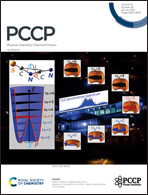Enhancing the photoelectrochemical activity of monoclinic BiVO4 by discretizing oxygen vacancies: insights from DFT calculations†
Abstract
Monoclinic bismuth vanadate (BiVO4) has emerged as an excellent optically active photoanode material due to its unique physical and chemical properties. Experiments reported that the low concentration of oxygen vacancies enhances the photoelectrochemical (PEC) activity of BiVO4, but the high concentration of oxygen vacancies decreases the charge carrier lifetime. Using time-domain density functional theory and molecular dynamics, we have demonstrated that the distribution of oxygen vacancies has strong effects on the static electronic structure and nonadiabatic (NA) coupling of the BiVO4 photoanode. The localized oxygen vacancies create charge recombination centers within the band gap and enhance the NA coupling between the VBM and the CBM, resulting in fast charge and energy losses. By contrast, the discrete oxygen vacancies can eliminate the charge recombination centers and decrease the NA coupling between the VBM and the CBM, enhancing the PEC activity of monoclinic BiVO4. Our study suggests that the PEC performance of a photoanode can be improved by changing the distribution of oxygen vacancies.



 Please wait while we load your content...
Please wait while we load your content...